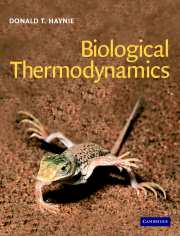Book contents
- Frontmatter
- Contents
- Preface
- Chapter 1 Energy transformation
- Chapter 2 The First Law of Thermodynamics
- Chapter 3 The Second Law of Thermodynamics
- Chapter 4 Gibbs free energy – theory
- Chapter 5 Gibbs free energy – applications
- Chapter 6 Statistical thermodynamics
- Chapter 7 Binding equilibria
- Chapter 8 Reaction kinetics
- Chapter 9 The frontier of biological thermodynamics
- Appendix A General references
- Appendix B Biocalorimetry
- Appendix C Useful tables
- Appendix D BASIC program for computing the intrinsic rate of amide hydrogen exchange from the backbone of a polypeptide
- Glossary
- Index of names
- Subject index
Chapter 7 - Binding equilibria
Published online by Cambridge University Press: 31 May 2010
- Frontmatter
- Contents
- Preface
- Chapter 1 Energy transformation
- Chapter 2 The First Law of Thermodynamics
- Chapter 3 The Second Law of Thermodynamics
- Chapter 4 Gibbs free energy – theory
- Chapter 5 Gibbs free energy – applications
- Chapter 6 Statistical thermodynamics
- Chapter 7 Binding equilibria
- Chapter 8 Reaction kinetics
- Chapter 9 The frontier of biological thermodynamics
- Appendix A General references
- Appendix B Biocalorimetry
- Appendix C Useful tables
- Appendix D BASIC program for computing the intrinsic rate of amide hydrogen exchange from the backbone of a polypeptide
- Glossary
- Index of names
- Subject index
Summary
Introduction
In earlier chapters we saw how the First and Second Laws are combined in a thermodynamic potential function called the Gibbs free energy. We have also seen how the Gibbs energy can be used to predict the direction of spontaneous change in a wide variety of systems under the constraints of constant temperature and pressure. One type of application of the Gibbs energy which we studied in Chapter 5 is the binding of a ligand to a macromolecule. In Chapter 6 we were introduced to statistical thermodynamics, a mathematical formalism that permits a molecular interpretation of thermodynamic quantities. The present chapter combines and extends all the main ideas we have encountered thus far. Binding is an extremely common and immensely important phenomenon of biochemistry. While binding can be considered just one of many different types of equilibrium process, the central role it plays in the physiology of biological macromolecules makes the present chapter one of the most important ones of this book.
Before plunging into a sea of complex mathematical equations, let's do a brief survey of areas in biology where binding plays a role. In our discussion of the First Law (Chapter 2) we encountered RNase A, a digestive enzyme that can bind tightly to a nucleotide inhibitor. Then in Chapter 5 we looked at receptor–ligand interactions and an introductory analysis of oxygen binding to hemoglobin.
- Type
- Chapter
- Information
- Biological Thermodynamics , pp. 223 - 250Publisher: Cambridge University PressPrint publication year: 2001



